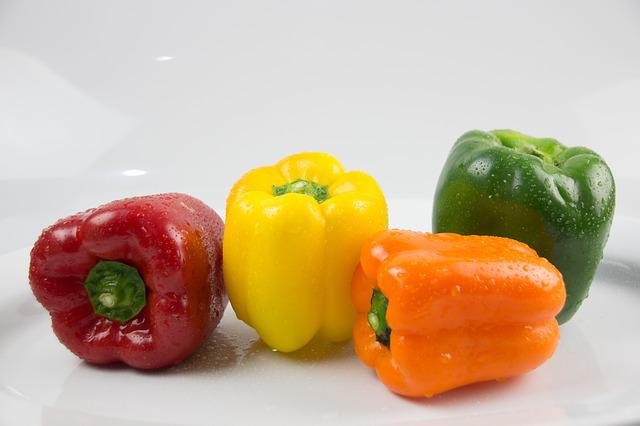
When peppers appear in the markets in their many color variations, we realize that summer has indeed arrived! Let’s discover the properties of this vegetable.
Peppers are vegetables belonging to the large Solanaceae family, the same family which includes tomatoes, aubergines and potatoes. However, this family includes numerous species, for this reason peppers and potatoes, for example, are not so similar to each other.
The pepper plant is native to South America, although its cultivation is practically widespread everywhere. Naturally it prefers warm climates, it is no coincidence that when we think of peppers, southern Italy and summer come to mind.
Its colors also remind us of the summer season, in fact there are green, yellow, red peppers and peppers with various intermediate shades. There are also various shapes, from large and round ones to long and thin ones and, of course, there are sweet and spicy peppers. Now let’s explore the properties of peppers.
Peppers: calories and nutritional properties
Peppers have a rather low calorie content, of about 27 calories per 100 grams, which can vary depending on the variety: green peppers, in fact, provide 20 kcal per 100 grams and red ones about 30 kcal. For yellow peppers, the calorie content per 100 grams is approximately 26 kcal.
This difference is due to the fact that green peppers are actually a more unripe form of the vegetable, which therefore contains less carbohydrates and more water.
In general, peppers contain a lot of water, little proteins and almost no fats, but they have a lot of mineral salts and vitamins, which make them valuable foods from a nutritional point of view. In particular, peppers are rich in vitamin C (100 grams of pepper provide more than the recommended daily amount of vitamin C), potassium, vitamin A and lutein, a carotenoid that offers various benefits to the eye. Below is the table of the nutritional values of peppers.
Nutritional values per 100g of peppers:
- Kcal: 26
- Carbohydrates: 4.2 g
- Fat: 0.3 g
- Proteins: 0.9 g
- Fibers: 1.9 g
- Waterfall: 92.3 g
- Iron: 0.7 mg
- Soccer: 17 mg
- Sodium: 2 mg
- Potassium: 210 mg
- Phosphorus: 28 mg
- Zinc: 0.2 mg
- Vitamin B1: 0.05 mg
- Vitamin B2: 0.07 mg
- C vitamin: 151 mg
- Vitamin B3: 0.5 mg
- Vitamin B6: 0.27 mg
- Vitamin E: 0.65 mg
- Vitamin A: 139 mg
Peppers: the health benefits
These colorful and particular summer vegetables, as well as brighten the eye and bring with them all the warmth of a summer day, also have numerous beneficial properties and contribute to our health. By eating them we can fill up on vitamins and mineral salts, essential micronutrients for the well-being of our body. Let’s see in detail all the benefits of peppers.
✓ Moisturizers
Peppers are made up of about 92% of their weight in water, so we understand how they can help us maintain an adequate state of hydration, especially in the hot season, when we need it most. By putting them in our dishes as a side dish, especially raw in salads, we will benefit the most from this property.
✓ Diuretics and detoxifiers
Due to the high water content, peppers help us to maintain the hydro-saline balance, that is, to more easily expel excess liquids and with them waste and toxins. The high potassium content and moderate sodium content also contribute to this.
✓ Allies of fitness
The fact that peppers have a low calorie content makes them suitable for a low-calorie diet, also because with their organoleptic characteristics they are well suited to various preparations. When combined with other foods, they become a single dish that can satisfy our appetite even if we have to control calories!
✓ Remineralizers
Peppers are rich in minerals such as iron, calcium, phosphorus, zinc, all important elements for our body, which it cannot do without, so if we want to fill up on mineral salts we can certainly rely on peppers.
✓ Benefits for the circulatory system
Vitamin C and the antioxidant agents that pepper contains ensure that this vegetable has beneficial properties for our cardiovascular system. In fact, it has protective effects on blood vessels, thus improving circulation and preventing the fragility of capillaries.
✓ Allies of the heart
In addition to protecting the circulatory system, peppers also help the cardiovascular system as the antioxidant compounds help lower blood cholesterol levels and thus prevent cardiovascular disease and protect the heart.
✓ Friends of the intestine
We have seen that peppers contain a considerable amount of water, which together with the fibers, contributes to the well-being of our intestine by promoting its motility and emptying with a cleaning action.
✓ Protective for the eyes
The carotenoids contained in peppers, and in particular lutein, carry out a protective action for the eyes and together with vitamin C and vitamin E have a preventive action for the development of degenerative diseases of the retina.
Red, yellow and green peppers: the nutritional differences
We have seen that the different varieties of peppers have a slightly different calorie content, which naturally depends on their nutritional composition. Green peppers, in fact, contain more water and many mineral salts, yellow peppers have a high content of beta carotene, an antioxidant molecule precursor of vitamin A, red pepper contains more vitamin C. For these small differences, every type of pepper it also lends itself to different preparations.
How many peppers to eat
A portion of peppers corresponds to about 100 g and in the summer period, when these vegetables are in season, we can also consume them several times a week, supplementing them with other seasonal vegetables in order to ensure that our diet is varied.
How to use peppers in cooking Fresh peppers should preferably be chosen organic, firm and visibly free of dark spots. As for the seeds inside the peppers, it is possible to leave them or eliminate them, taking into account, however, that the elimination of the seeds improves their digestibility. Same thing goes for the peel: eliminating it will also improve the digestibility of the pepper. We will explore this aspect in a little while.
The ideal way to eat peppers is to consume them raw, in order to fully preserve the integrity of the vitamins they contain and which are easily perishable with heat. We can therefore think of adding them to salads or of tasting them in a pinzimonio cut into strips together with carrots, celery and fennel. In this way we could prepare a delicious, healthy and low-calorie aperitif for summer evenings.
If we want to cook peppers, however, the most used cooking methods are steamed, boiled, baked or grilled; cooking times vary according to the mode chosen:
- Steam peppers: cut the peppers into small pieces or rings and let them cook for about 15-18 minutes (the smaller the pieces are, the less time it takes to cook them);
- Boiled peppers: also in this case they can be cut into slices and left to boil for about 10 minutes;
- Baked peppers: baked peppers cook in about 30-35 minutes at 180 ° C;
- Grilled peppers: in this case, the pepper is generally cut into 3 or 4 parts and placed on the grill for a few minutes, until it is cooked.
Baked or grilled peppers can be combined with garlic, parsley and mint and then make a side dish by seasoning them with a drizzle of extra virgin olive oil.
Peppers also lend themselves very well to accompany white meat main courses, such as chicken, it is no coincidence that chicken with peppers is a classic, just as peppers stuffed with cereals such as rice, barley, quinoa are a classic. In this way we can make a light dish if we use whole grains, lots of herbs to flavor and baking with parchment paper so as not to overdo the oil.
And if we have little time and want to prepare a tasty side dish, we can simply sear the peppers in a pan together with other vegetables and if we have prepared them in abundance, we can use them to season a nice plate of pasta, even cold, for hot summer days.
How to make peppers more digestible
For many of us, peppers are not very digestible and this is due to various factors. First of all, like all Solanaceae, peppers also contain solanine, which is a toxic substance if ingested in large quantities and which as such creates problems in digestion . This substance is more present in peppers that are not very ripe or ripened in unsuitable conditions, for example in a greenhouse and not under the sun, so the first advice to improve their digestibility is undoubtedly to consume the peppers only when they are in season and maybe prefer the red or yellow ones which, as we have seen, are the more mature ones.
As we have already anticipated above, peppers could be indigestible also due to the peel and seeds they contain, so we could deprive them of these parts simply by having the patience to clean them well or by cooking them in the oven to remove the peel more easily.
The cooking method also influences the digestibility of peppers: frying and elaborate seasonings, in fact, only weigh down the digestion process. Choosing the right combination is also important: if we eat peppers together with foods that are in themselves more difficult to digest, such as aged cheeses, fatty meats, eggs, we will only accentuate their indigestibility.
Contraindications of peppers
Peppers, especially spicy ones, contain capsaicin, a chemical compound that when taken in high doses creates a burning sensation both in the mucous membranes of the mouth, and in those of the stomach and intestines, so a moderate intake of peppers is recommended for people suffering from gastroesophageal reflux, gastritis and inflammatory diseases of the stomach and intestines.
Furthermore, the solanine contained in peppers is disposed of by the liver, so those with liver diseases must avoid excessive consumption of peppers and take them with the precautions just seen, that is, choosing ripe peppers and depriving them of seeds and peel, where the solanine is concentrated.
Since both capsaicin and solanine put the liver through hard work, it would be wise for children not to eat peppers or consume them in very small amounts and occasionally. There are also specific allergies to some chemical compounds present in peppers, so, of course, those who are allergic to these substances will not be able to eat peppers.






